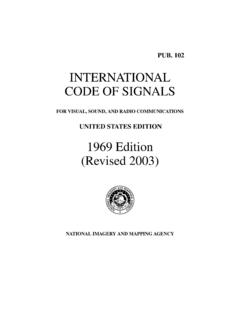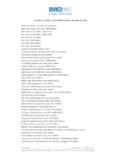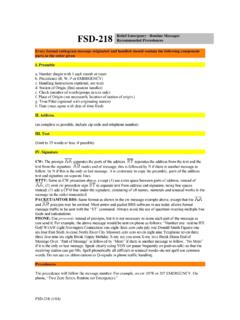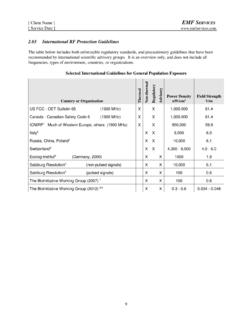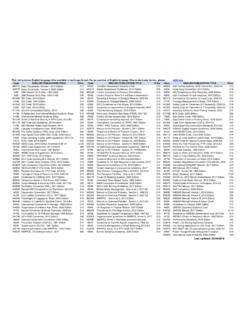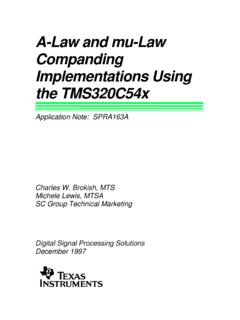Transcription of International Code of Conduct on the Distribution …
1 International code of Conduct on the Distribution and Use of Pesticides Guidelines on Efficacy Evaluation for the Registration of Plant Protection Products FOOD AND AGRICULTURE ORGANIZATION OF THE UNITED NATIONS JUNE 2006 This publication was developed in the IOMC context. The contents do not necessarily reflect the views or stated policies of individual IOMC Participating Organizations. The Inter-Organisation Programme for the Sound Management of Chemicals (IOMC) was established in 1995 following recommendations made by the 1992 UN Conference on Environment and Development to strengthen co-operation and increase International co-ordination in the field of chemical safety. The participating organisations are FAO, ILO, OECD, UNEP, UNIDO, UNITAR and WHO. The World Bank and UNDP are observers.
2 The purpose of the IOMC is to promote co-ordination of the policies and activities pursued by the Participating Organisations, jointly or separately, to achieve the sound management of chemicals in relation to human health and the environment. The designations employed and the presentation of material in this information product do not imply the expression of any opinion whatsoever on the part of the Food and Agriculture Organization of the United Nations (FAO) concerning the legal or development status of any country, territory, city or area or of its authorities, or concerning the delimitation of its frontiers or boundaries. The mention of specific companies or products of manufacturers, whether or not these have been patented, does not imply that these have been endorsed or recommended by FAO in preference to others of a similar nature that are not mentioned.
3 The views expressed in this information product are those of the author(s) and do not necessarily reflect the views of FAO. All rights reserved. FAO encourages the reproduction and dissemination of material in this information product. Non-commercial uses will be authorized free of charge, upon request. Reproduction for resale or other commercial purposes, including educational purposes, may incur fees. Applications for permission to reproduce or disseminate FAO copyright materials, and all queries concerning rights and licences, should be addressed by e-mail to or to the Chief, Publishing Policy and Support Branch, Office of Knowledge Exchange, Research and Extension, FAO, Viale delle Terme di Caracalla, 00153 Rome, Italy. FAO 2006 3 Table of contents 1. 2. SCOPE OF EFFICACY Objectives of efficacy Efficacy evaluation as part of the registration Elements of efficacy Direct efficacy (effectiveness).
4 12 Agronomic 12 Economic 13 3. DATA GENERATION FOR EFFICACY Data Local trials 14 Trials data from other 14 Public domain 15 15 Good experimental practice (GEP)..16 Organization and staff 17 17 Record keeping and 18 Verification and quality 18 4. GENERAL PRINCIPLES FOR THE DESIGN OF EFFICACY Minimum effective 19 Testing 19 Location of Number of Factors influencing the required number of trials for direct 20 Basic number of trials for direct 21 Increased number of trials for direct 21 Reduced number of trials for direct 22 Number of trials for crop 23 5. DESIGN, Conduct AND ANALYSIS OF EFFICACY Experimental Type of 24 Number of plots and power of the 25 Plot size and 25 Reference product and untreated 26 Target (pest) Application of plant protection Environmental Assessment of biological Other Analysis of 6.
5 CROP Effects on Effects on quality and Effects on plants or plant parts used for 7. AGRONOMIC Resistance Effects on succeeding Effects on adjacent Effects on beneficial 8. The biological Record keeping and reporting of individual The field 37 The trial 37 The trial series 38 9. PRINCIPLES FOR ASSESSING ACCEPTABILITY OF Direct Comparison with the untreated 39 Comparison with a reference 39 Comparison with other pest management 40 Crop 40 Agronomic 40 Effects on succeeding 40 Effects on adjacent 41 Effects on non-target 41 10. SPECIFIC Minor Biological control agents, semiochemicals and plant Protection of stored plant ANNEX EXAMPLES OF REGIONAL/ International HARMONIZATION OF THE EFFICACY EVALUATION OF PLANT PROTECTION ANNEX FORMAT OF THE BIOLOGICAL ANNEX CONSTITUTING A FIELD ANNEX INFORMATION TO BE RECORDED DURING TRIALS AND CONTENTS OF THE TRIAL 5 Abbreviations CILSS Comit Permanent Inter Etats de Lutte contre la S cheresse au Sahel (Permanent Interstate Committee for Drought Control in the Sahel)
6 EPPO European and Mediterranean Plant Protection Organization EU European Union FAO Food and Agriculture Organization of the United Nations GEP Good Experimental Practice GLP Good Laboratory Practice IPM Integrated Pest Management IPPC International Plant Protection Convention N Recommended dose (of the plant protection product) NAFTA North American Free Trade Agreement OECD Organization for Economic Co-Operation and Development OIRSA Organismo Internacional Regional de Sanidad Agropecuaria SOP Standard Operating Procedure WHO World Health Organization WHOPES World Health Organization Pesticide Evaluation Scheme 6 Definitions For the purpose of these guidelines, the following definitions of terms apply. Active ingredient means the biologically active part of the pesticide1. It is also referred to as the active substance.
7 Biological dossier means the part of the data set that is submitted in support of a request for registration of a plant protection product which provides all necessary information to allow a reliable assessment of the efficacy of that product (also referred to as biological assessment dossier or efficacy dossier). Biological control agent means a natural enemy, antagonist or competitor, and other self-replicating biotic entity used for pest control2 Crop tolerance evaluation means the assessment of (potential) adverse effects of the plant protection product on the crop that is to be treated, such as phytotoxicity, adverse effects on crop yield and quality, and effects on plants or plant parts used for propagation. Efficacy evaluation means the assessment of the effectiveness of a plant protection product, against the target pest, which may include an assessment of its agronomic sustainability and economic benefits.
8 Formulation means the combination of various ingredients designed to render the product useful and effective for the purpose claimed; the form of the pesticide as purchased by Good Experimental Practice (GEP) means the measures taken and practices followed with respect to organization, design, Conduct , monitoring, recording and reporting of efficacy trials of plant protection products, with the aim to ensure that the trial and its results are reliable, comparable and Good Laboratory Practice (GLP) is a quality system concerned with the organisational process and the conditions under which non-clinical health and environmental safety studies are planned, performed, monitored, recorded, archived and Integrated Pest Management (IPM) means the careful consideration of all available pest control techniques and subsequent integration of appropriate measures that discourage the development of pest populations and keep pesticides and other interventions to levels that are economically justified and reduce or minimize risks to human health and the environment.
9 IPM emphasizes the growth of a healthy crop with the least possible disruption to agro-ecosystems and encourages natural pest control 1 Definition as provided in the International code of Conduct on the Distribution and Use of Pesticides [2]. 2 Definition as provided in the Glossary of Phytosanitary Terms of the International Plant Protection Convention (IPPC) [75] 3 Definition based on the EPPO Standard on Conduct and Reporting of Efficacy Evaluation Trials, including Good Experimental Practice [20] 4 Definition as provided in the OECD Principles on Good Laboratory Practice [50]. 7 Minimum effective dose is the dose of a plant protection product that is the minimum necessary to achieve sufficient efficacy against the target pest across the broad range of situations in which the product will be applied (also referred to as lowest effective rate).
10 5 Minor uses are those uses of plant protection products in which either the crop is considered to be of low economic importance at national level (minor crop), or the pest is not important on a major crop (minor pest)6 Pest means any species, strain or biotype of plant, animal or pathogenic agent injurious to plants or plant Pesticide means any substance or mixture of substances intended for preventing, destroying or controlling any pest, including vectors of human or animal disease, unwanted species of plants or animals causing harm during or otherwise interfering with the production, processing, storage, transport or marketing of food, agricultural commodities, wood and wood products or animal feedstuffs, or substances which may be administered to animals for the control of insects, arachnids or other pests in or on their bodies.










